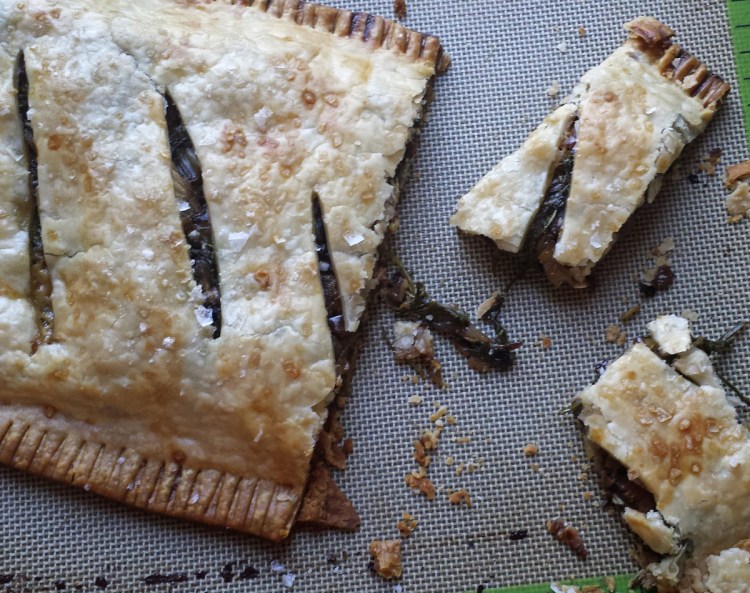I’m totally done with the bitter cold of the 2017-18 Maine winter. But I’m perfectly happy to keep eating the bitter greens Maine farmers will continue to bring to market until the sweeter things – sweet lettuces, sweet peas, sweet berries – start to crop up.
Thanks to high tunnels and hydroponic growing systems, Maine eaters have had access to locally grown arugula, escarole, kale (and now kale rabe, mesclun mix, mustard greens, radicchio and baby spinach) all winter long. But we aren’t done with these bitter ingredients for the season yet, folks. You can still find plenty around for sale, and a few others – dandelion greens, nettles and sorrel among them – can be foraged in early spring. Just as fancy cocktails featuring liquid bitters, Maine’s growing list of hoppy beers and bitter chocolate bars made with high cacao content are all the rage right now, bitter greens are better celebrated than disdained.
Bitter, as one of the five basic elements of taste, gets a bad rap because humans have an innate aversion to it. According to Jennifer McLagan, author of “Bitter: A Taste of the World’s Most Dangerous Flavor,” our tongues are covered in taste buds that can detect even small traces of bitterness. It’s a natural defense against poisons, many of which are very bitter. When we taste something bitter, we grimace and spit. This response is strongest in babies, who are affected the most by even the smallest trace of poison. It fades with age as we lose some taste buds and acquire a taste for bitter-tasting food and drink like dark chocolate, coffee and alcohol. Bitter foods, we find as we age, can (for better or for worse) stimulate our nervous systems in various ways – think of coffee’s buzz and alcohol’s ability to lower inhibitions.
There are better reasons to eat life’s bitter foods, McLagan writes. They often contain compounds like carotenoids (in spinach), flavonoids (in cranberries and kale) and polyphenols (in wine) that keep the skin and nervous system healthy and inflammation and cholesterol in check. In the mouth, bitter foods stimulate the production of gastric acid in the stomach, which aids in their digestion, making their nutrients more readily available to the body.
In the kitchen, they are imperative, McLagan writes. “Eschewing bitter is like cooking without salt or eating without looking. Without bitterness, we lose a way to balance sweetness. … Food without bitterness lacks depth and complexity.”
In the local food system, they’re imperative, too. Buying and eating bitter greens at this time of year generates much needed cash flow for farmers as they begin to plant summer crops but must wait months before those crops pay out.

BITTER GREENS AND BOUNCY CHEESE STRUDEL
This recipe is adapted from Jennifer McLagan’s book “Bitter: A Taste of the World’s Most Dangerous Flavor.” She calls for radicchio alone, but I like to mix in other greens for added color, texture and flavor. Once the mud dries here in Maine, I’ll weave in dandelion greens, too. McLagan uses Italian Fontina cheese, but any semi-soft cow’s milk cheese will do just fine. I refer to these as bouncy cheese, as when you poke their rind, the cheese bounces back.
Serves 6
2 ounces chopped bacon, prosciutto or pancetta (about 1/3 cup)
1 leek, light green and white parts, chopped and rinsed (about 1 cup)
8 ounces chopped radicchio (about 2 cups)
3 ounces arugula (about 2 cups)
2 tablespoons balsamic vinegar
Flaky sea salt
1/4 teaspoon crushed red chili pepper flakes
4 ounces semi-soft cow’s milk cheese, diced into ¼-inch pieces
1 double crust pie dough recipe
1 egg, beaten
2 tablespoons fresh bread crumbs
Place bacon, prosciutto or pancetta in a large frying pan over low heat and cook slowly until the fat is rendered and the meat is just beginning to crisp. Add the leeks to the pan and increase the heat to high. Cook, stirring, for about 2 minutes. Add the radicchio and cook it until it turns brown and wilts slightly. Remove from the heat and add arugula, vinegar, 1 teaspoon salt and red pepper flakes. Cool to room temperature. Stir in the cheese.
Preheat the oven to 375 degrees F. Line a rimmed baking sheet with parchment paper or a silicone mat.
Roll 1 piece of pie dough into a 13-by- 8-inch rectangle. Place the pastry on the prepared baking sheet. Brush the edges of the pastry with the beaten egg. Sprinkle the breadcrumbs evenly over the dough, keeping them within the egg-washed border, then mound the bitter greens mixture on top, making sure the cheese is evenly distributed. Roll the second piece of pastry into a slightly bigger rectangle, about 14 by 9 inches. Place the second rectangle over the top of the radicchio mixture and press the pastry edges together. Trim the edges, then use a fork to seal them well.
Brush the pie with the remaining egg wash and cut 5 or 6 diagonal slits in the top, and sprinkle with flaky sea salt. Bake for 35 to 40 minutes, or until the pastry is golden brown and the filling is beginning to bubble up through the slits. Transfer to a cooling rack and let sit for at least 10 minutes before cutting. Serve hot or at room temperature.
CHRISTINE BURNS RUDALEVIGE is a food writer, recipe developer and tester, and cooking teacher in Brunswick, and the author of “Green Plate Special,” a cookbook from Islandport based on these columns. She can be contacted at cburns1227@gmail.com.
Send questions/comments to the editors.



Comments are no longer available on this story